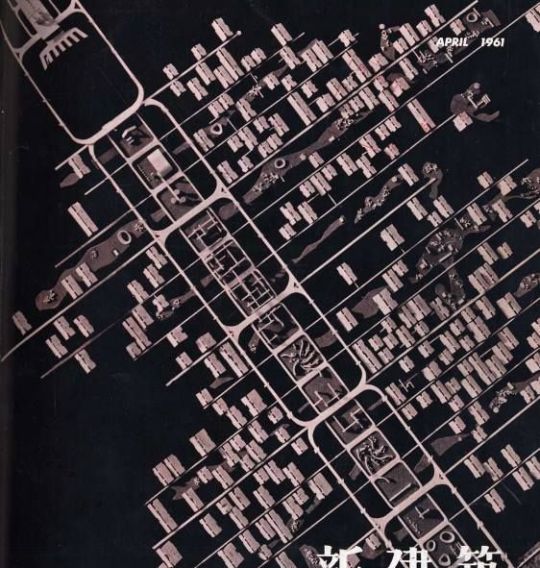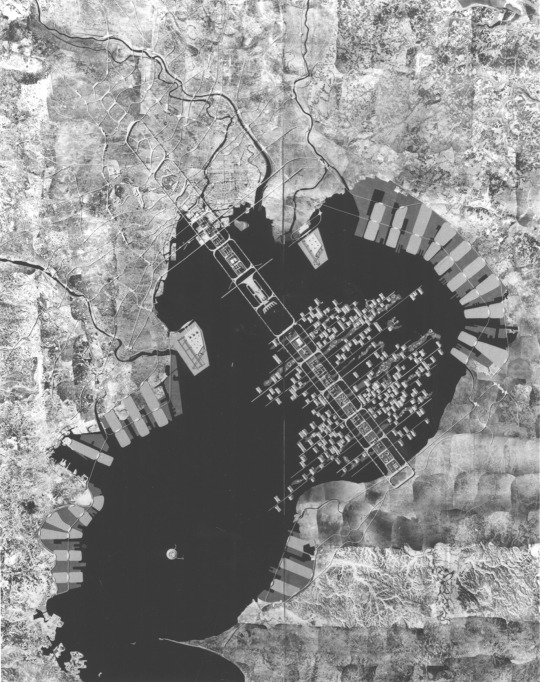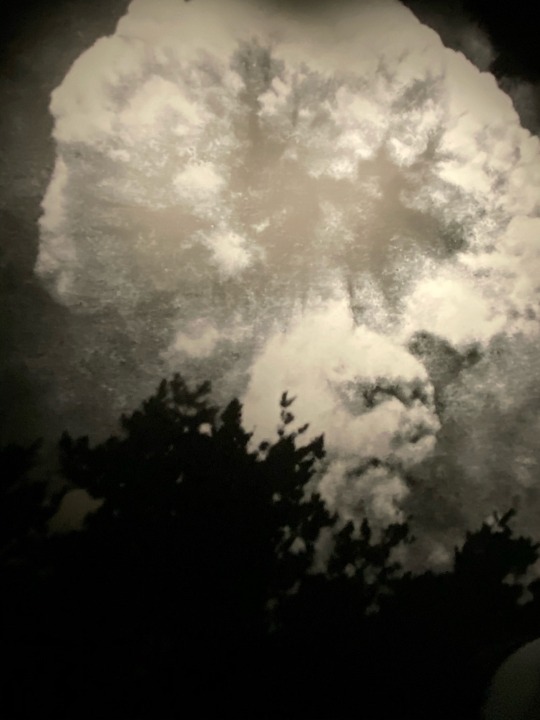#kenzō tange
Text










Tokyo expansion plan
Tokyo, Japan
1960
Kenzō Tange (1913–2015), architect
Arata Isozaki (1931–2022), architect
Kishō Kurokawa (1934–2007), architect
#kenzō tange#arata isozaki#kishō kurokawa#tokyo#japan#asia#1960s#20th century#architecture#infrastructure#urban#ideal cities#inhabited infrastructure#patterns#reading and writing the city
25 notes
·
View notes
Text
0 notes
Photo

Kenzō Tange, Shizuoka Newspaper Company Building, 1967
16 notes
·
View notes
Photo

Lumbini, Nepal designed by Japanese architect Kenzō Tange in 1978. Photo by Miku Dixit.
730 notes
·
View notes
Quote
I believe the development of a new architectural style will result from further study and work on the three elements that I have discussed: human, emotional, and sensual elements; technologically intelligent elements; and social-communicational structure of the space.
Kenzō Tange, 1987 Laureate, The Pritzker Architecture Prize, Ceremony Acceptance Speech
#quote#Kenzo Tange#Tange#Japan#architecture#Metabolism#Metabolist movement#Japanese architecture#technology#urbanism#space#architectural theory#Pritzker#Pritzker Prize
43 notes
·
View notes
Text
「Haus Hyazinth」- Inheriting A Poet’s Dream
In 1939, Tachihara Michizō passed away at age 24 due to complications caused by tuberculosis. He left behind many things from poems to an unfinished project he had.

Other than the poems he wrote describing the urban life, Tachihara also dreamed of being an architect, he was enrolled to the Architecture Deparmtent of the University of Tokyo. After graduating, he would join the Ishimoto Architectural & Engineering Firm.
Tachihara himself viewed architecture as “Man’s scramble to find God’s attributes” as noted on his graduation thesis, mainly influenced by his views of “the natural” and the “the artificial” as so often found in his poems’s imagery of urban life.
“Open the window: you can see the clouds floating; birds flying; you can see the tiles on the roof. I swear these are the most amazing things.”
- Tachihara Michizō, Letter to Ikuta Tsutomu (1935)
Tachihara’s architectural work was an inspiration to other architects such as Ōe Hiroshi, Tange Kenzō others. One project which Tachihara never got to finish was his Haus Hyazinth.

Photo from Tachihara Michizō Memorial Society
In a letter to his classmate, Tachihara told his friend about his grim outlook about his later years, dreaming about spending his life in a house by a swamp in Urawa, Saitama. At that time many of Tachihara’s friends lived in Urawa including the poet Jinbo Kōtarō, the painter Kokuta Suda and Satomi Akimasa. With this, Tachihara decided that he wanted to build the house around the Bessho-numa park located at Saitama.
On a different letter directed to Jinbo, Tachihara would decide to name the House as “Hyacinth House”, stylized as “Haus Hyazinth”. In total Tachihara made around 50 designs according to his letters but decided on the design shown in the picture above, however due to his tuberculosis getting worse, he was unable to continue the project.
Inheriting A Poet’s Dream
After the poet’s death, an association was set up to bring the poet’s dream house to life. The Hyacinth House Association was set up in order to build the Haus Hyazinth, the house would later be completed in the year 2004.



Photo from ohkaksan.com
The house was about 16.5 square meters with simple furnishing including a bed and a table for writing. The dimensions and design of the house followed closely to the designs sketched up by Tachihara during this tenure in designing the house.
While Tachihara is a rather obscure poet in comparison to many other characters in Bungō Stray Dogs or any other Bungō series for that matter. I still find it heartwarming about those who still remember a writer’s works and helping them attain their dream. Even if that dream is something as simple as a house for Tachihara to spend his weekends at.
Sources:
[関連出版物の通信販売]. Tachihara Memorial Hall
[ヒアシンスハウスについて]. haus-hyazinth.org
[ヒアシンスハウスを見る ]. 近代建築の楽しみ
[Despite early death, poet’s dream home built 65 years later]. VOX POPULI Column of Asahi Shimbun
The Poetry of Architecture Doomed: Michizo Tachihara’s Neo-classicism during the 1930's by Hiroshi Emoto
#bungou stray dogs#tachihara michizou#michizo tachihara#bsd tachihara#japanese literature#history#bsd
38 notes
·
View notes
Photo

Yoyogi National Gymnasium by Kenzō Tange
(via 30olympics-notebook9-superJumbo.jpg (2048×2048))
138 notes
·
View notes
Photo

Fuji TV building // Minato, Tokio Japan
丹下健三 - Kenzō Tange (1997)
119 notes
·
View notes
Photo

Kagawa Prefectural Government Office, Kenzō Tange
Source: Comingupwilhouse
21 notes
·
View notes
Photo

The Fuji Tv building, designed by Kenzō Tange - Odaiba, Tokyo, 2013
#travel#japan#architecture#modern architecture#urban landscape#original photographers#photographers on tumblr#b&w photography#building#kenzo tange#fuji tv
52 notes
·
View notes
Photo








The modernist architecture of Skopje
219 notes
·
View notes
Photo

Kagawa Prefectural Government Office Kenzō Tange The Kagawa Prefectural Government Hall on the island of Shikoku was completed in 1958. Its expressive construction could be likened to the Daibutsu style seen at the Tōdai-ji in Nara. The columns on the elevation bore only vertical loads so Tange was able to design them to be thin, maximising the surfaces for glazing. Although the hall has been called one of his finest projects, it drew criticism at the time of its construction for relying too heavily on tradition. (Kagawa Prefecture) https://www.instagram.com/p/B7kgmCbjxWe/?igshid=2beth0jext6p
1 note
·
View note
Photo

Hiroshima Peace Memorial Museum
Street view
Hiroshima Peace Memorial Museum - 1955 by Kenzō Tange
Browse our interactive map
55 notes
·
View notes
Photo








Photographies c. 1964
Kokuritsu Yoyogi Kyōgi-jō 国立代々木競技場 - Le Gymnase olympique de Yoyogi - Yoyogi National Gymnasium - Tōkyō - construit entre 1961 et 1964 pour abriter les épreuves de natation et de plongeon des Jeux olympiques d'été de 1964.
Architecte : Tange Kenzō 丹下 健三 (1913 - 2005).
#tange kenzo#kenzo tange#famous architect#japan#architecte célèbre#japon#kokuritsu yoyogi kyogijo#tokyo
685 notes
·
View notes
Text










Friday, October 25, 2019
Today we took the bullet train to Hiroshima. We went directly to the Hiroshima Peace Memorial Museum. The Hiroshima Peace Memorial Museum is a museum located in Hiroshima Peace Memorial Park, in central Hiroshima, Japan, dedicated to documenting the atomic bombing of Hiroshima in World War II. The museum was established in August 1955 with the Hiroshima Peace Memorial Hall (now the International Conference Center Hiroshima [ja]). It is the most popular of Hiroshima's destinations for school field-trips from all over Japan and for international visitors. 53 million people had visited the museum from its opening in 1955 through 2005, averaging over one million visitors per year. The architect of the main building was Kenzō Tange. He main building displays personal belongings left behind by the victims and exhibits describing the horrors and devastation of the atomic bin to help children nvey what happen in Hiroshima on August 6, 1945. In the Easr building, you can access video testimonies of the A-bomb survivors, there was an exhibit about the dangers of nuclear weapons and another about Hiroshima history. Outside of the museum is Peace Park, the Cenotaph for the A-bomb victims, the Children’s Peace Monument, the Hypocenter, where the bomb detonated, the Atomic Bomb Memorial Mound, and the A-bomb Dome. At 8:15am on 6th August 1945, the first atomic bomb in human history was dropped on Hiroshima. Although, the Atomic Bomb Dome was located almost directly underneath the explosion, it somehow avoided complete destruction and the remains of the building still stand today. The residents of Hiroshima decided to keep this tragic reminder of war intact. The site was designated as a World Heritage Site in 1996.
This was such an interesting and meaningful place to visit. We learned so much about what happened on this day in history, and were so amazed at the city today. There we many school children visiting the site, and we enjoyed interacting with them. A few came up to us and asked about where we were from and what peace meant to us. And then they gave us origami cranes as a thank you.
1 note
·
View note
Photo

Kenzō Tange — Jingūmae, Tokyo Even after seeing this view daily for years, some days it’s a diamond. #burndiary #hikaricreative #spicollective #capturestreets #therawsociety #90sarchitecture #kenzotange #brutalism #CCwalks (at Shibuya, Tokyo) https://www.instagram.com/p/Bu8gV3OjBYb/?utm_source=ig_tumblr_share&igshid=1pkopkr9vc1qs
#burndiary#hikaricreative#spicollective#capturestreets#therawsociety#90sarchitecture#kenzotange#brutalism#ccwalks
2 notes
·
View notes